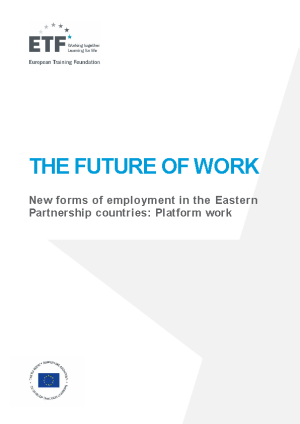The future of work – New forms of employment in the Eastern Partnership countries: Platform work
Key highlights
The study investigates changing patterns of work triggered by digitalisation in the six Eastern Partnership (EaP) countries: Armenia, Azerbaijan, Belarus, Georgia, Moldova and Ukraine. It aims in particular to fill the knowledge gaps on emerging platform work in the region, both web-based and on-location.
While Ukraine and, to a lesser extent, Belarus had already been globally recognised as being among the European leaders in highly qualified platform labour, our findings also indicate a relatively high prevalence of platform work among Armenian freelancers. In Georgia, Azerbaijan and Moldova these forms of employment are still emerging. New business models driven by innovation have the potential to contribute to competitiveness and employment growth, including through new entrepreneurial activities.
Workers from all the six countries access international Russian- and English-language web-based platforms. The most widespread web-based engagement relates mainly to higher-complexity specialist work in the information and communications technology (ICT) sector (software development and technology) and the creative and multimedia industry, in line with labour market demand. On-location international platforms are also present in these countries, and already face strong competition from locally grown platforms. The most widespread types of on-location platform work in the region are ride-hailing and delivery services conducted via mobile apps.
The emergence and growing popularity of remote and freelance work, including through labour outsourcing for clients in the developing EaP economies, is likely to be linked to its flexibility and job creation features in the context of underperforming labour markets. Online platforms also ease entry into the labour market, enable individuals to offer their services to international clients, and provide new sources of income. The growth of high-complexity web-based platform work in the region is driven by the demand for these skills around the world, but it is also conditioned by the presence of a qualified workforce. Relevant occupational skills, digital literacy and knowledge of foreign languages are key for making the most of new opportunities.
The impact of the Covid-19 pandemic varies across the countries and the types of platform. Lockdowns introduced by the authorities resulted in a drop in demand for on-location services such as ride-hailing. At the same time, the situation has particularly encouraged remote platform work due to lockdowns and the rise in unemployment in the traditional economy.
Platform work brings many opportunities, but at the same time many risks. One serious challenge is the increasing exposure of workers to global competition. Policy actions will need to ensure that national rules protect workers, while maintaining the flexibility and innovation potential of the platforms.
The report aims to trigger a wider reflection on policy implications arising from the new trends in online labour and skills demand and changes in work organisation. The assessment considers possible measures to mitigate challenges and foster opportunities (digital access), protect workers (labour legislation, social security and social dialogue) and enhance skills formation, development and utilisation (education and training provision, including career guidance and skills recognition). The analysis focuses on both country-specific and common regional elements, which could direct national and regional actions, including those supported by the European Union.
Did you like this publication? If you would like to be notified when new content like this is published, subscribe to receive our email alerts.
